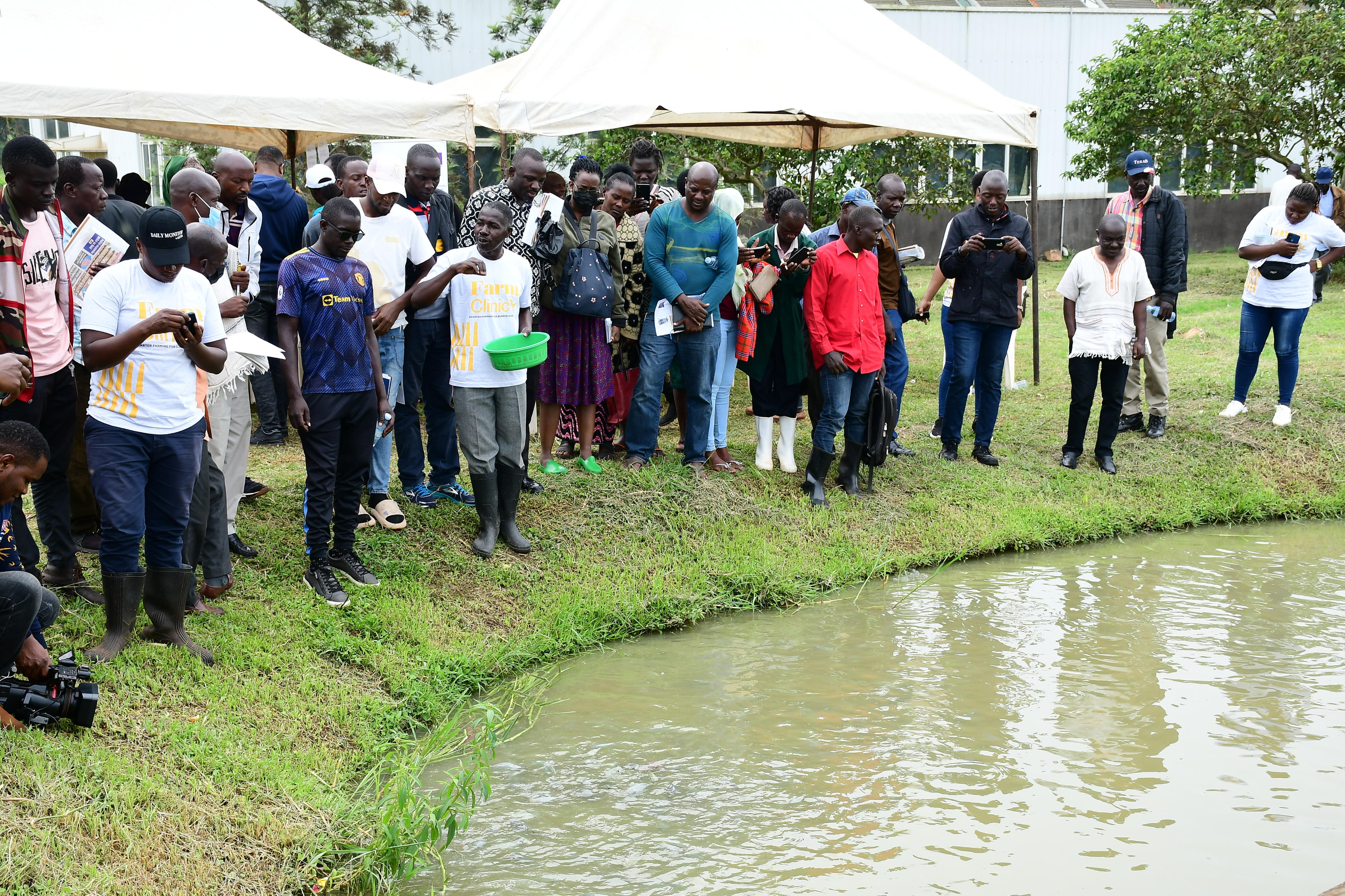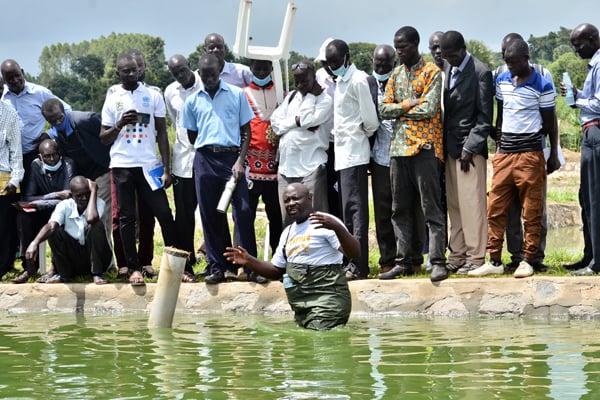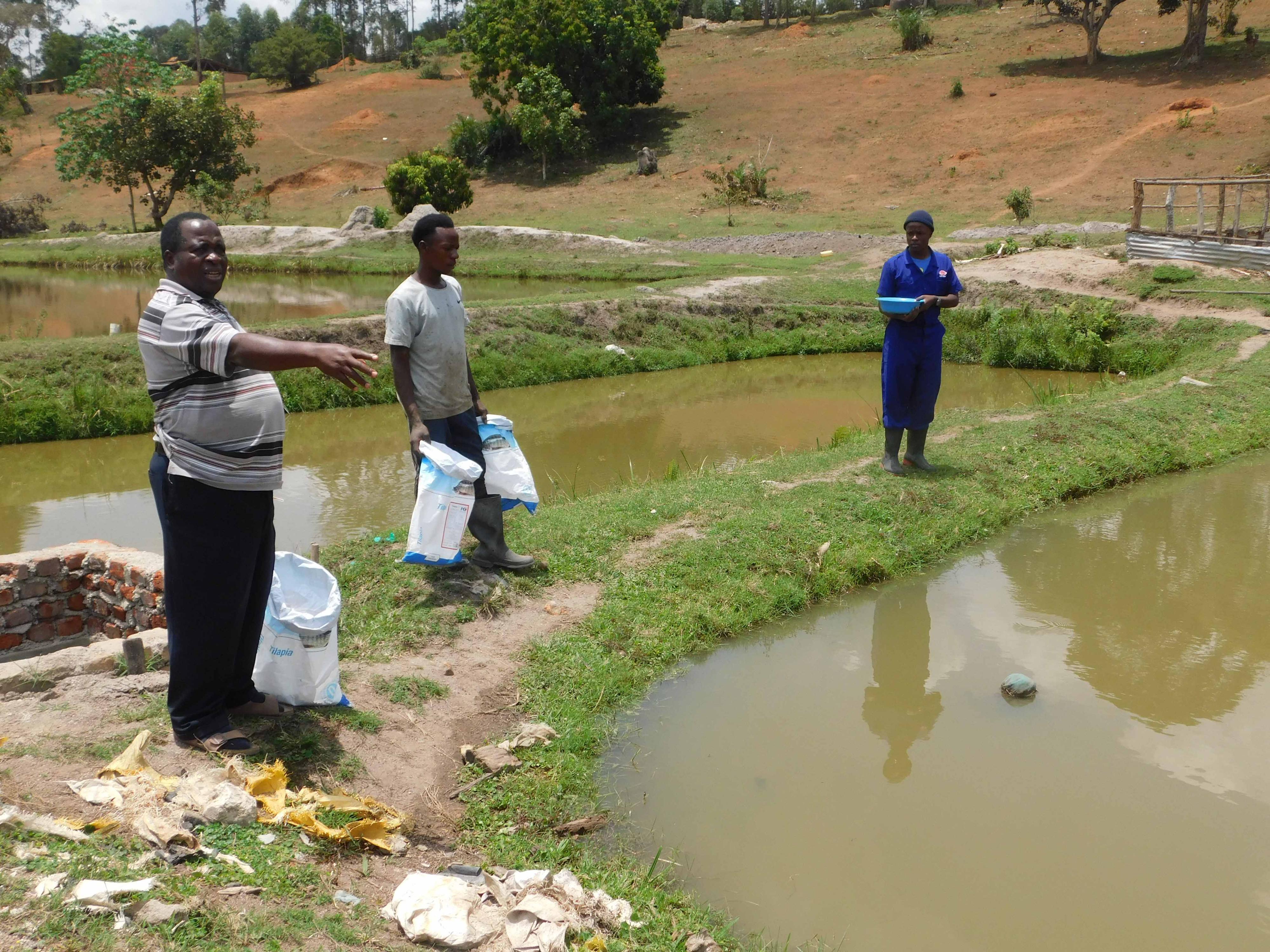Prime
Fish farming: Key things that must be at your fingertips

Farmers look on as an agronomist explains how to feed fish. Photos/Abubaker Lubowa
What you need to know:
- The Farm Clinics are usually segmented into trainings, question and answer sessions, one-on-one interactions between experts and farmers and demonstrations.
Some came by foot, others used boda bodas. Some drove themselves to the venue, while others hopped on taxis.
The early morning rains did not dampen their enthusiasm as they converged at National Fisheries Resource Research Institute (NaFIRRI), some two kilometres off Entebbe highway in Kajjansi, for the 31st edition Seeds of Gold farm clinic.
Armed with cameras, recorders, notebooks and pens and a copy of the Saturday Monitor, the farmers were here on a mission to pick up valuable information in fish farming that will enable them improve their agribusinesses.
Trainers
Waiting to engage them were experts from Naro, NaFIRRI, Bank of Uganda, Zoetis, Stanbic Bank and NSSF among others.
Richard Senkwale, Nation Media Group – Uganda business executive, said the clinics have presented a golden opportunity to farmers to access quality information from experts.
“We work with all the research institutions under Naro because they are the farming experts. In addition, we also showcase some of the successful farmers to share their skills and experience with other farmers,” he says.
Mujib Nkambo, a scientist, at NaFIRRI took both prospective and active farmers through the steps of fish farming. Here is how to get it right.
Species selection
This depends on climatic conditions of an area, water quality and supply and most importantly, market needs. Fish species suitable for culturing in Uganda can be categorised into two; the cold and warm water species.
Cold water species require low water temperatures, relatively low dissolved oxygen and continuous supply of high quality water. Warm water species, on the other hand, require less intensive management. Common species include tilapia and cat fish.

A farmer asks a question during the Seeds of Gold Farm Clinic. Photo/Abu Lubowa
Things to consider
When choosing a suitable species to culture, consider the following;
Terrain: Fish ponds should be constructed in areas with a slope of not more than one percent and near a steady water source. This helps to use gravity in inflow and draining of the ponds. Higher inclinations increases the cost of construction and predisposes the ponds to collapse of dykes.
Soil type: Ponds should be constructed on soils that are 20 to 35 percent clay. Sandy soils are porous while clay soils are too compact and absorptive, thus, may deprive water some essential nutrients for fish to flourish.
Water source: Water used in fish ponds should be from natural sources such as rivers, lakes, boreholes or rain. The water should have high level of dissolved oxygen and free of silt, poison, predators and unwanted fish. Ponds should not be sited in areas prone to flooding as this may cause heavy losses from washed or escaped fish.
Size of the pond: The size of the pond depends on purpose, production system and the intended scale of the venture. Ponds intended for breeding purposes are generally smaller compared to the ones used for raising fish. The size of the pond also depends on the target population one intends to produce.
Once you identify a proper site, the next step is to construct the pond. The shape of the pond does not matter much as this is intended to fit the topography. However, rectangle ponds are easy to construct and manage. The depth of the pond depends on the fish species to keep, the size and production system.
As a rule of thumb, deep end should not exceed a depth of 1.2 metres at water level and the shallow end should not be less than 0.4 metres. Shallow ponds predispose the fish to predation, weed encroachment and reduces stocking capacity thereby lowering productivity.
Around the pond, strong dykes (walls or embankments) should be constructed to avoid walls from collapsing and water overflowing when the pond is filled.
Draining the pond is a routine management practice intended to help in preventing overflowing, harvesting, eradicating predators, de-silting, and improving the bottom conditions of the pond. The drainage should be from where the pond is deepest.
Management
After constructing a fish pond, what follows is a series of routine practices to maximise production. Proper and accurate records should be kept for every activity taking place in the pond.
Routine management practices include stocking, feeding, fertilisation, controlling water levels, quality, pH, weeds, predators, diseases, harvesting and marketing.
Apply lime and organic manure in the pond before refilling new stock. Agricultural lime is most preferred and should be evenly applied on the floor. Rates of application depend on the alkalinity of the water or soil pH. Where the soil pH or alkalinity is not known, the minimum recommended amount of lime should be applied.
Stocking rates
Stocking density of a fish pond depends on fish species and pond productivity. However, in extensively managed earthen ponds, a stocking rate of about one to two fingerings per m2 is recommended for monocultures of tilapia.
This rate can be increased with improved management to optimise pond productivity. Where catfish is introduced in tilapia ponds to control population, a ratio of 1:10 (a catfish per every 10 tilapia) should be considered.
Catfish should be introduced when tilapia is at least three times the size of former. The stocking rate for catfish monocultures is about two to three fingerings per m2 but can be increased to about five fingering per m2 if there is good management. With proper management, the fish should attain market weight at about six to nine months depending on water temperatures.

Farmers listen as a Bank of Uganda offcial explains the ACF fund.
Feeding your fish
Tilapia fingerings are omnivorous, feeding mainly on tiny water organisms as well as dead organic matter (detritus) and as they increase in size, they become entirely herbivorous and feed on small water plants. Similarly, at young stages the catfish and common carp fingerings are omnivorous and as they increase in size, they become predatory.
Tilapia are surface water feeders and prefer feeding during the day, while catfish and common carp are bottom water feeders and prefer darkness when feeding.
Fish can be provided with supplemental or commercial feeds especially where the stocking rate is high to avoid starving. Kitchen and slaughter house waste, oil seed cakes and grains are among supplemental feeds.
When feeding the fish, ensure time, place, quantity and quality are maintained as disruption may induce stress to the fish.
Water quality
Water quality is determined by turbidity, temperatures, pH, dissolved oxygen and minerals. Highly turbid water impairs vision especially for surface water feeders such as tilapia interfering with their feeding.
Catfish on the other hand, depend on their smell and touch in search of food and can tolerate reasonable turbidity. Regardless of the fish species, low dissolved oxygen lowers their activity particularly feeding.
Weeds, predators and disease control
Weeds and predation are the most serious challenges in earthen ponds. Diseases are not very common partly due to the low rates of fish farming and because cultures used are native to the tropics and, therefore, tolerant to common diseases.
Weeds can be controlled by continuously trimming unnecessary vegetation along the banks of the pond and deepening shallow ponds to recommended depths. Common predators include birds (pelicans, kingfishers and herons), frogs, tadpoles, predator fish, dogs, snakes and wild carnivores and human beings.
To control predation from land, a perimetre fence should be installed and a net placed over the pond. Drying the ponds prior to restocking is a good way of killing frog eggs. Common indicators of stressed fish include gulping air, abrupt change in feeding behaviour, whirling or swimming erratically away from others, distended stomach, discolouration, peeling skin and ulcerations, among others.




